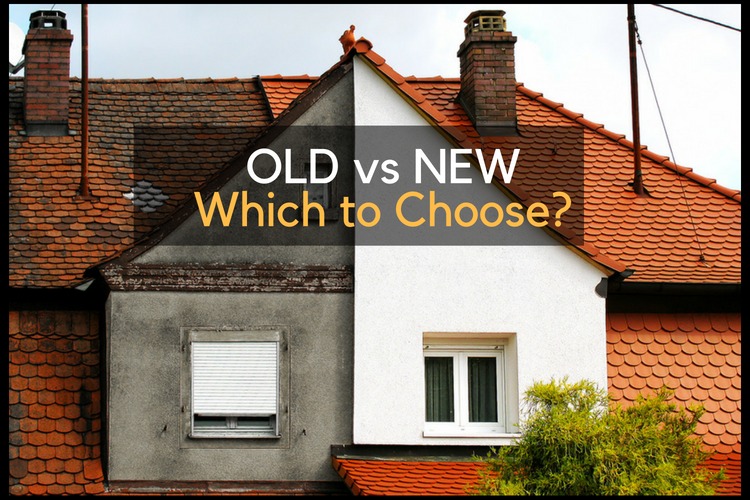Moving home is not a decision to be taken lightly; there are a lot of choices to make about where you want to live, how many bedrooms you want, whether you want a garden, and much more. However, one of the most important decisions to make at the outset of your home move is whether to buy an older, preowned house or a new-build one.
We’ve pulled together all the pros and cons of moving into both an older house and a new house, so that you can make your decision with all the facts in front of you.

Buying an old or preowned house
Depending on the age of the property, older houses are often valued by buyers for their charm. They can be a great combination of aged, weathered history and a strong and reliable foundation. Often, beyond the unique external features of an older property, the main appeal is that they usually provide more space overall than newer properties, especially in terms of garden size.
If you want to buy an old house, we’d recommend that you get a building survey to make sure you’re aware of what repairs may need to be done in the property, plus it will highlight any hidden issues that could impact your decision to buy it. Also, make sure to budget for any repairs you may need to carry out when you move in.
But, before you make a decision, let’s look at the pros and cons:
Pro: more space available
As we mentioned above, many older houses were built at a time when rooms were more spacious, houses were less crowded together and more space was given to gardens. For that reason, many older houses will also come with driveways and more off-road parking.
Pro: more substantial building materials
The materials used to build an older property tended to be more substantial; older builds were more likely to be made with brick or stone, instead of the more common materials these days of breezeblocks, timber frames and plasterboard.
Con: outdated heating, electrical or plumbing systems
One area to consider is that with older properties the systems might not have been updated. So you may find that an older property will take longer to warm up and could “leak heat” due to less effective insulation. You may also find that the electrics need to be updated. Electrical regulations are constantly changing so while it would be quite a task for every household to keep up to the latest regulations, you may find that in an older property the electrics need some work.
Con: expensive wear and tear repairs
The issue of wear and tear may be more prevalent in an older property e.g. damp, leaks, or worn out features and décor in need of an update. You may have to fork out larger amounts of money to fix any issues you uncover, since fixing older systems, or redecorating an entire property would cost more than purchasing new build where everything is brand new already.
Buying a new house
While buying an old house can be appealing due to the character of the property, there’s often a lot of updating needed, and sometimes depending on the nature of the property, ongoing maintenance. This could be anything from just the décor through to a whole refurbishment. The opposite can be said of newer builds and they may be easier to maintain in the long run too.
Let’s consider the positives and negatives:
Pro: energy efficiency and warranty
In comparison to old houses, new houses are often far more energy-efficient, since they’ve been built with modern systems and are well-insulated with features like cavity walls and double glazing – this also makes them cheaper to run. And, you may not need to look far if something does go wrong as most new build properties come under warranty for around 10 years.
Pro: easily customisable
A new build can often be likened to a blank canvas – there aren’t usually any specific features or issues to work around – you can just make it your own, to suit your own personal style. If you sign on to a new-build project early on in the construction timeline, you may even be able to choose certain elements as they go in, such as what colour carpets you’d like or the specific kitchen you want.
Pro: no strings attached
Buying a completely new build home means that there’s no chain of purchase for you to be aware of. You don’t need to wait for someone to move out or complete buying their own home.
Con: thinner walls
Due to the use of breezeblock and plasterboard in newer homes, walls are often a lot thinner than those in older houses, since they were built with stone or brick and offer more natural sound proofing. This may mean you hear more of your neighbours than you would in an older house!
Con: ongoing development
In an older property, they are usually in established areas and you know what your neighbourhood is going to look like. With new builds, the developments often are not finished so you don’t know what other building work may take place nearby or what the finished development with look like. Also, don’t forget to consider how the nearby traffic will flow with the extra housing that has been built.
Con: snagging
With an older property you expect some level of updating to been required. In a new property it can be frustrating to have paid a premium to buy new then find you are regularly asking the developer to come back to fix issues.
If you’re looking to buy a home in the Wokingham and Crowthorne area, we can give you a helping hand with your decision-making process. With our specialist knowledge, we will be able to tell you everything you need to know about the local market to help you find the perfect house for you. Search our properties or call us to find out more on Wokingham 0118 977 6776 or Crowthorne 01344 779 999.

